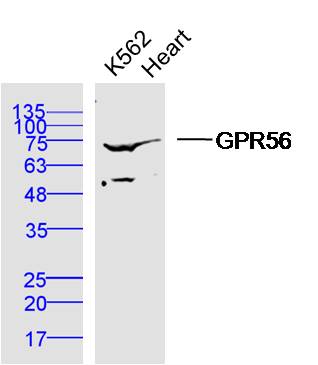
Rabbit Anti-GPR56 antibody
BFPP; DKFZp781L1398; EGF TM7 like; G protein coupled receptor 56; GPR 56 ; Polymicrogyria bilateral frontoparietal; TM7LN4; TM7XN1; TM7XN1 protein; GPR56_HUMAN.
View History [Clear]
Details
Product Name GPR56 Chinese Name 蛋白偶联受体56抗体 Alias BFPP; DKFZp781L1398; EGF TM7 like; G protein coupled receptor 56; GPR 56 ; Polymicrogyria bilateral frontoparietal; TM7LN4; TM7XN1; TM7XN1 protein; GPR56_HUMAN. Research Area Tumour Cell biology Neurobiology The cell membrane受体 G protein-coupled receptor G protein signal Immunogen Species Rabbit Clonality Polyclonal React Species Human, Mouse, (predicted: Rat, Dog, Pig, Cow, Horse, Rabbit, ) Applications WB=1:500-2000 ELISA=1:5000-10000
not yet tested in other applications.
optimal dilutions/concentrations should be determined by the end user.Theoretical molecular weight 78kDa Cellular localization The cell membrane Form Liquid Concentration 1mg/ml immunogen KLH conjugated synthetic peptide derived from human GPR56: 275-350/693 <Extracellular> Lsotype IgG Purification affinity purified by Protein A Buffer Solution 0.01M TBS(pH7.4) with 1% BSA, 0.03% Proclin300 and 50% Glycerol. Storage Shipped at 4℃. Store at -20 °C for one year. Avoid repeated freeze/thaw cycles. Attention This product as supplied is intended for research use only, not for use in human, therapeutic or diagnostic applications. PubMed PubMed Product Detail G protein-coupled receptors (GPRs or GPCRs), also known as seven transmembrane receptors, heptahelical receptors, or 7TM receptors, are members of the largest protein family and play a role in many different stimulus-response pathways. G-protein coupled receptors mediate extracellular signals into intracellular signals (G-protein activation). They respond to a great variety of signaling molecules, including hormones, neurotransmitters and other proteins and peptides. GPR proteins are integral seven-pass membrane proteins with some conserved amino acid regions. G-protein coupled receptor 56 (GPR56), also designated TM7XN1 protein, contains one GPS domain. GPR56 plays an important role in cell-cell interactions and is widely expressed, with highest levels detected in brain, heart and thyroid gland. Defects in the gene encoding for GPR56 can cause bilateral frontoparietal polymicrogyria (BFPP) which is characterized by disorganized cortical lamination.
Function:
GPR56 contains 7 transmembrane domains as well as a mucin-like domain and cysteine box in the N-terminal region. Its expression is widely distributed and the highest levels can be found in brain, thyroid gland and heart. It is also expressed in a great number of tumor cells. Results show that mutations in GPR56 cause a human brain cortical malformation called bilateral frontoparietal polymicrogyria (BFPP); data suggest that GPR56 signaling plays an essential role in regional development of human cerebral cortex.
Subcellular Location:
Cell membrane. Multi-pass membrane protein.
Tissue Specificity:
Widely distributed with highest levels found in thyroid gland, brain and heart. Expressed in a great number of tumor cells.
Post-translational modifications:
The endogenous protein is proteolytically cleaved into 2 subunits, an extracellular subunit and a seven-transmembrane subunit.
DISEASE:
Defects in GPR56 are the cause of bilateral frontoparietal polymicrogyria (BFPP) [MIM:606854]. BFPP is characterized by disorganized cortical lamination that is most severe in frontal cortex.
Similarity:
Belongs to the G-protein coupled receptor 2 family. LN-TM7 subfamily.
Contains 1 GPS domain.
SWISS:
Q9Y653
Gene ID:
9289
Database links:Entrez Gene: 9289 Human
Entrez Gene: 14766 Mouse
Omim: 604110 Human
SwissProt: Q9Y653 Human
SwissProt: Q8K209 Mouse
Unigene: 513633 Human
Unigene: 290834 Mouse
Unigene: 1677 Rat
Product Picture
Bought notes(bought amounts latest0)
No one bought this product
User Comment(Total0User Comment Num)
- No comment



 +86 571 56623320
+86 571 56623320
 +86 18668110335
+86 18668110335

